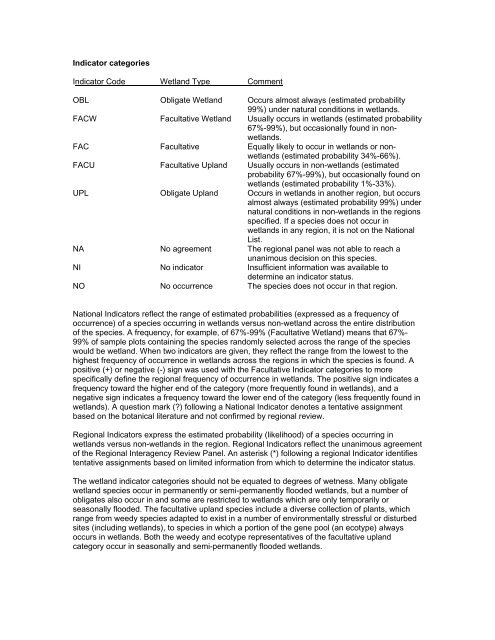Wetland Plant Guide Region 2 - The Swamp School
Wetland Plant Guide Region 2 - The Swamp School
Wetland Plant Guide Region 2 - The Swamp School
Create successful ePaper yourself
Turn your PDF publications into a flip-book with our unique Google optimized e-Paper software.
Indicator categories<br />
Indicator Code <strong>Wetland</strong> Type Comment<br />
OBL Obligate <strong>Wetland</strong> Occurs almost always (estimated probability<br />
99%) under natural conditions in wetlands.<br />
FACW Facultative <strong>Wetland</strong> Usually occurs in wetlands (estimated probability<br />
67%-99%), but occasionally found in non-<br />
wetlands.<br />
FAC Facultative Equally likely to occur in wetlands or non-<br />
wetlands (estimated probability 34%-66%).<br />
FACU Facultative Upland Usually occurs in non-wetlands (estimated<br />
probability 67%-99%), but occasionally found on<br />
wetlands (estimated probability 1%-33%).<br />
UPL Obligate Upland Occurs in wetlands in another region, but occurs<br />
almost always (estimated probability 99%) under<br />
natural conditions in non-wetlands in the regions<br />
specified. If a species does not occur in<br />
wetlands in any region, it is not on the National<br />
List.<br />
NA No agreement <strong>The</strong> regional panel was not able to reach a<br />
unanimous decision on this species.<br />
NI No indicator Insufficient information was available to<br />
determine an indicator status.<br />
NO No occurrence <strong>The</strong> species does not occur in that region.<br />
National Indicators reflect the range of estimated probabilities (expressed as a frequency of<br />
occurrence) of a species occurring in wetlands versus non-wetland across the entire distribution<br />
of the species. A frequency, for example, of 67%-99% (Facultative <strong>Wetland</strong>) means that 67%-<br />
99% of sample plots containing the species randomly selected across the range of the species<br />
would be wetland. When two indicators are given, they reflect the range from the lowest to the<br />
highest frequency of occurrence in wetlands across the regions in which the species is found. A<br />
positive (+) or negative (-) sign was used with the Facultative Indicator categories to more<br />
specifically define the regional frequency of occurrence in wetlands. <strong>The</strong> positive sign indicates a<br />
frequency toward the higher end of the category (more frequently found in wetlands), and a<br />
negative sign indicates a frequency toward the lower end of the category (less frequently found in<br />
wetlands). A question mark (?) following a National Indicator denotes a tentative assignment<br />
based on the botanical literature and not confirmed by regional review.<br />
<strong>Region</strong>al Indicators express the estimated probability (likelihood) of a species occurring in<br />
wetlands versus non-wetlands in the region. <strong>Region</strong>al Indicators reflect the unanimous agreement<br />
of the <strong>Region</strong>al Interagency Review Panel. An asterisk (*) following a regional Indicator identifies<br />
tentative assignments based on limited information from which to determine the indicator status.<br />
<strong>The</strong> wetland indicator categories should not be equated to degrees of wetness. Many obligate<br />
wetland species occur in permanently or semi-permanently flooded wetlands, but a number of<br />
obligates also occur in and some are restricted to wetlands which are only temporarily or<br />
seasonally flooded. <strong>The</strong> facultative upland species include a diverse collection of plants, which<br />
range from weedy species adapted to exist in a number of environmentally stressful or disturbed<br />
sites (including wetlands), to species in which a portion of the gene pool (an ecotype) always<br />
occurs in wetlands. Both the weedy and ecotype representatives of the facultative upland<br />
category occur in seasonally and semi-permanently flooded wetlands.


